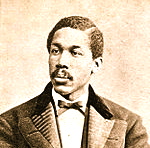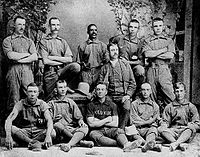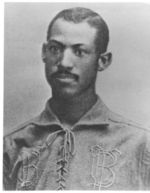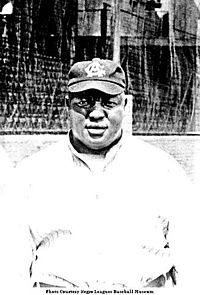Negro League Baseball


A Docudrama about the Triumph and Tragedy of the Negro Leagues. A Social Studies Project entered in National History Day.
The Negro leagues were United States professional baseball leagues comprising teams predominantly made up of African Americans. The term may be used broadly to include professional black teams outside the leagues and it may be used narrowly for the seven relatively successful leagues beginning in 1920 that are sometimes termed “Negro Major Leagues”.
In 1885 the Cuban Giants formed the first black professional baseball team. The first league, the National Colored Base Ball League, was organized strictly as a minor league but failed in 1887 after only two weeks owing to low attendance. The Negro American League of 1951 is considered the last major league season and the last professional club, the Indianapolis Clowns, operated amusingly rather than competitively from the mid-1960’s to 1980’s.
The Negro leagues were United States professional baseball leagues comprising teams predominantly made up of African Americans. The term may be used broadly to include professional black teams outside the leagues and it may be used narrowly for the seven relatively successful leagues beginning in 1920 that are sometimes termed “Negro Major Leagues.”
In 1885 the Cuban Giants formed the first black professional baseball team. The first league, the National Colored Base Ball League, was organized strictly as a minor league but failed in 1887 after only two weeks owing to low attendance. The Negro American League of 1951 is considered the last major league season and the last professional club, the Indianapolis Clowns, operated amusingly rather than competitively from the mid-1960’s to 1980’s.
Octavius Catto, black baseball pioneer
Because blacks were not being accepted into the major and minor baseball leagues, they formed their own teams and had made professional teams by the 1880s. The first known baseball game between two named black teams was held on September 28, 1860, at Elysian Fields in Hoboken, New Jersey. The Weeksville of New York beat the Colored Union Club 11–0. In 1862, a newspaper reporter looking for a game between two white teams stumbled upon a game between black teams and covered it for his paper. At the time, baseball was commonly deemed recreation around which social gatherings were held.
Immediately after the end of the American Civil War in 1865 and during the Reconstruction period that followed, a black baseball scene formed in the East and Mid-Atlantic states. Comprising mainly ex-soldiers and promoted by some well-known black officers, teams such as the Jamaica Monitor Club,Albany Bachelors, Philadelphia Excelsiors and Chicago Uniques started playing each other and any other team that would play against them.
By the end of the 1860s, the black baseball mecca was Philadelphia, which had an African-American population of 22,000. Two former cricket players, James H. Francis and Francis Wood, formed thePythian Base Ball Club. They played in Camden, New Jersey, at the landing of the Federal Street Ferry, because it was difficult to get permits for black baseball games in the city. Octavius Catto, the promoter of the Pythians, decided to apply for membership in the National Association of Base Ball Players, normally a matter of sending delegates to the annual convention; beyond that, a formality. At the end of the 1867 season “the National Association of Baseball Players voted to exclude any club with a black player.” In some ways Blackball thrived under segregation, with the few black teams of the day playing not only each other but white teams as well. “Black teams earned the bulk of their income playing white independent ‘semipro’ clubs.”
Professional Baseball
Bud Fowler, the first professional black baseball player with one of his teams, Western of Keokuk, Iowa
Baseball featuring African American players became professionalized by the 1870s. The first known professional black baseball player was Bud Fowler, who appeared in a handful of games with a Chelsea, Massachusetts club in April 1878 and then pitched for the Lynn, Massachusettsteam in the International Association. Moses Fleetwood Walker and his brother, Welday Wilberforce Walker, were the first two black players in the major leagues. They both played for the 1884 Toledo Blue Stockings in the American Association.[9] Then in 1886 second basemanFrank Grant joined the Buffalo Bisons of the International League, the strongest minor league, and hit .340, third highest in the league. Several other black American players joined the International League the following season, including pitchers George Stovey and Robert Higgins, but 1888 was the last season blacks were permitted in that or any other high minor league.
Moses Fleetwood Walker, possibly the first African American major league baseball player
The Philadelphia Giants, owned by Walter Schlichter, a white businessman, rose to prominence in 1903 when they lost to the Cuban X-Giants in their version of the “Colored Championship”. Leading the way for the Cubans was a young pitcher by the name of Andrew “Rube” Foster. The following season, Schlichter, in the finest blackball tradition, hired Foster away from the Cubans, and beat them in their 1904 rematch. Philadelphia remained on top of the blackball world until Foster left the team in 1907 to play and manage the Leland Giants (Frank Leland renamed his Chicago Union Giants the Leland Giants in 1905).
Around the same time, Nat Strong, a white businessmen, started using his ownership of baseball fields in the New York City area to become the leading promoter of blackball on the East coast. Just about any game played in New York, Strong would get a cut. Strong eventually used his leverage to almost put the Brooklyn Royal Giants out of business, and then he bought the club and turned it into a barnstorming team.
When Foster joined the Leland Giants, he demanded that he be put in charge of not only the on-field activities, but the bookings as well. Foster immediately turned the Giants into the team to beat. He indoctrinated them to take the extra base, to play hit and run on nearly every pitch, and to rattle the opposing pitcher by taking them deep into the count. He studied the mechanics of his pitchers and could spot the smallest flaw, turning his average pitchers into learned craftsmen. Foster also was able to turn around the business end of the team as well, by demanding and getting 40 percent of the gate instead of the 10 percent that Frank Leland was getting.
By the end of the 1909, Foster demanded that Leland step back from all baseball operations or he (Foster) would leave. When Leland would not give up complete control, Foster quit, and in a heated court battle, got to keep the rights to the Leland Giants’ name. Leland took the players and started a new team named the Chicago Giants, while Foster took the Leland Giants and started to encroach on Nat Strong’s territory.
As early as 1910, Foster started talking about reviving the concept of an all-black league. The one thing he was insistent upon was that black teams should be owned by black men. This put him in direct competition with Strong. After 1912, Foster renamed his team the Chicago American Giants to appeal to a larger fan base. During the same year, J. L. Wilkinson started the All Nations traveling team. The All Nations team would eventually become one of the best-known and popular teams of the Negro leagues, the Kansas City Monarchs.
On April 6, 1917, the United States entered World War I. Manpower needed by the defense plants and industry accelerated the migration of blacks from the South to the North. This meant a larger and more affluent fan base with more money to spend. By the end of the war in 1919, Foster was again ready to start a Negro baseball league.
On February 13 and 14, 1920, talks were held in Kansas City, Missouri that established the Negro National League and its governing body the National Association of Colored Professional Base Ball Clubs. The league was initially composed of eight teams: Chicago American Giants, Chicago Giants, Cuban Stars, Dayton Marcos, Detroit Stars, Indianapolis ABC’s, Kansas City Monarchs and St. Louis Giants. Foster was named league president and controlled every aspect of the league, including which players played on which teams, when and where teams played, and what equipment was used (all of which had to be purchased from Foster). Foster, as booking agent of the league, took a five percent cut of all gate receipts.





